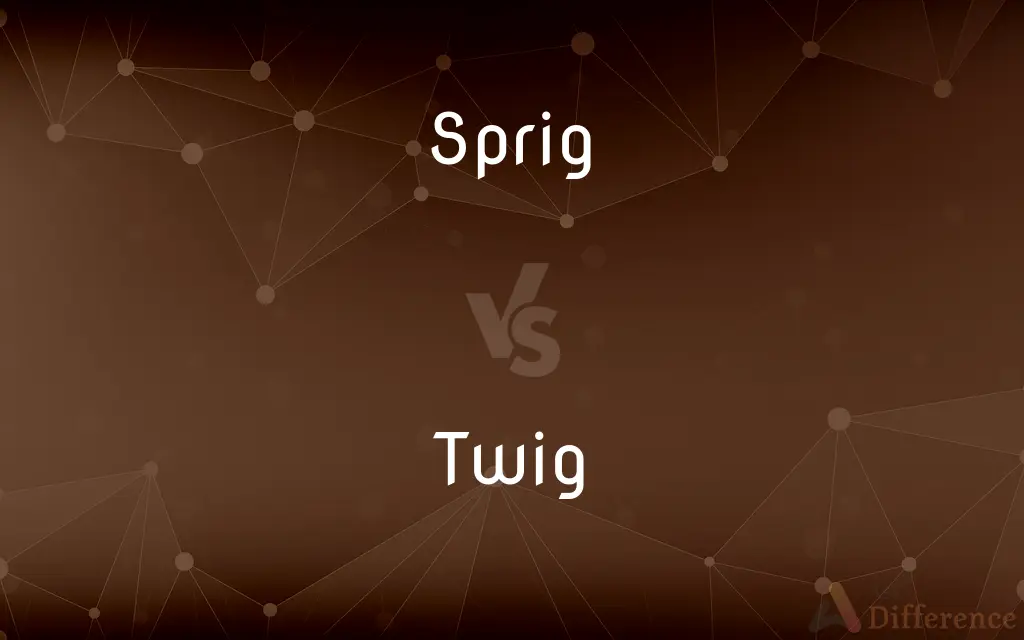Sprig vs. Twig — What's the Difference?
By Tayyaba Rehman & Maham Liaqat — Updated on April 3, 2024
A sprig typically refers to a small stem bearing leaves or flowers, often used for garnishing or decoration, whereas a twig is a small, thin branch of a tree or shrub.

Difference Between Sprig and Twig
Table of Contents
ADVERTISEMENT
Key Differences
Sprigs are often associated with fresh herbs and are used both in cooking for flavor and as garnish due to their leaves and sometimes flowers. On the other hand, twigs are recognized for their woody structure and are often devoid of leaves or flowers, used more for their structural qualities in crafts or as kindling.
While sprigs are usually specific to plants that are herbaceous and often aromatic, such as parsley, thyme, or mint, implying a certain softness and pliability, twigs come from a wider variety of trees and shrubs, suggesting a more rigid and durable character. Sprigs, due to their association with herbs, carry a connotation of freshness and flavor, enhancing dishes not only visually but also gustatorily. Twigs, however, serve more functional or aesthetic purposes in non-culinary contexts, such as in making nests or decorative arrangements.
Sprigs are generally harvested with a particular culinary or decorative use in mind, emphasizing the importance of the leaves or flowers they bear. In contrast, twigs are often collected as a byproduct of pruning or natural shedding by trees and shrubs, valued for their structural attributes rather than their appearance or taste.
The term "sprig" implies a certain level of tenderness and is often associated with younger, more delicate plants. Twigs, by nature, are hardier and can come from both young and mature plants, highlighting their versatility and resilience.
Comparison Chart
Definition
A small stem bearing leaves or flowers.
A thin, small branch of a tree or shrub.
ADVERTISEMENT
Primary Use
Culinary and decorative.
Structural and decorative.
Texture
Soft and pliable.
Hard and rigid.
Source Plants
Herbaceous, aromatic plants.
A wide variety of trees and shrubs.
Connotations
Freshness, flavor, tenderness.
Durability, versatility, resilience.
Compare with Definitions
Sprig
A small stem or branch of a plant with leaves, flowers, or berries.
She added a sprig of parsley to each plate as garnish.
Twig
A metaphor for something thin or slight.
After his illness, he was thin as a twig.
Sprig
A small portion indicative of a larger whole, especially in nature.
Just a sprig of green in a vast desert was a sign of life.
Twig
The smallest unit of a branch used in crafting or construction.
The bird used twigs to build its nest.
Sprig
A young shoot from a plant.
Each sprig from the lavender contributes to the garden's aroma.
Twig
A figure in genealogy, representing a branch of a family.
That twig on the family tree is not well documented.
Sprig
A representation of a plant's branch used in heraldry or decoration.
The family crest featured a sprig of oak.
Twig
A small, slender branch of a tree or bush.
She collected twigs for the campfire.
Sprig
A cutting of a fresh herb used in cooking or as decoration.
A sprig of mint was used to enhance the cocktail's flavor.
Twig
A tool for drawing in sand or soft ground, historically.
He sketched the outline with a twig.
Sprig
A small shoot or twig of a plant.
Twig
A twig or stick is a thin branch of a tree or bush. The buds on the twig are an important diagnostic characteristic, as are the abscission scars where the leaves have fallen away.
Sprig
An ornament in this shape.
Twig
A young shoot representing the current season's growth of a woody plant.
Sprig
A small brad without a head.
Twig
Any small, leafless branch of a woody plant.
Sprig
(Archaic) A young, immature person.
Twig
The current style; the fashion.
Sprig
To decorate with a design of sprigs.
Twig
To observe or notice.
Sprig
To remove a sprig or sprigs from (a bush or tree).
Twig
To understand or figure out
"The layman has twigged what the strategist twigged almost two decades ago" (Manchester Guardian Weekly).
Sprig
To fasten with a small headless brad.
Twig
To be or become aware of the situation; understand
"As Europe is now twigging, the best breeding ground for innovators who know how to do business is often big, competitive companies" (Economist).
Sprig
A small shoot or twig of a tree or other plant; a spray.
A sprig of laurel or of parsley
Twig
A small thin branch of a tree or bush.
They used twigs and leaves as a base to start the fire.
Sprig
An ornament resembling a small shoot or twig.
Twig
(transitive) To beat with twigs.
Sprig
One of the separate pieces of lace fastened on a ground in applique lace.
Twig
To realise something; to catch on; to recognize someone or something.
He hasn't twigged that we're planning a surprise party for him.
Sprig
A youth; a lad.
Twig
To understand the meaning of (a person); to comprehend.
Do you twig me?
Sprig
A brad, or nail without a head.
Twig
To observe slyly; also, to perceive; to discover.
Sprig
A small eyebolt ragged or barbed at the point.
Twig
To pull
Sprig
A house sparrow.
Twig
To twitch;
Sprig
To decorate with sprigs, or with representations of sprigs, as in embroidery or pottery.
Twig
To tweak.
Sprig
A small shoot or twig of a tree or other plant; a spray; as, a sprig of laurel or of parsley.
Twig
To twitch; to pull; to tweak.
Sprig
A youth; a lad; - used humorously or in slight disparagement.
A sprig whom I remember, with a whey-face and a satchel, not so many years ago.
Twig
To understand the meaning of; to comprehend; as, do you twig me?
Sprig
A brad, or nail without a head.
Twig
To observe slyly; also, to perceive; to discover.
As if he were looking right into your eyes and twigged something there which you had half a mind to conceal.
Sprig
A small eyebolt ragged or barbed at the point.
Twig
To beat with twigs.
Sprig
To mark or adorn with the representation of small branches; to work with sprigs; as, to sprig muslin.
Twig
A small shoot or branch of a tree or other plant, of no definite length or size.
The Britons had boats made of willow twigs, covered on the outside with hides.
Sprig
Small branch or division of a branch; usually applied to branches of the current or preceding year
Twig
Small branch or division of a branch; usually applied to branches of the current or preceding year
Sprig
An ornament that resembles a spray of leaves or flowers
Twig
Branch out in a twiglike manner;
The lightning bolt twigged in several directions
Twig
Understand, usually after some initial difficulty;
She didn't know what her classmates were plotting but finally caught on
Common Curiosities
How do you identify a sprig on a plant?
A sprig is identified as a small stem or branch that bears leaves, flowers, or berries, often from an herbaceous plant.
Are all small branches considered twigs?
Yes, all small, thin branches of trees or shrubs can be considered twigs, regardless of their specific plant origin.
Can sprigs be replanted to grow new plants?
Some sprigs, especially those from herbaceous plants, can root and grow into new plants if properly planted and cared for.
Do sprigs only come from edible plants?
No, sprigs can come from any plant with suitable stems, leaves, or flowers, not just edible ones.
How long can a sprig stay fresh?
When properly stored in a refrigerator, a sprig can stay fresh for several days to a week.
What is a sprig used for?
Sprigs are primarily used in cooking for adding flavor or as decoration on dishes due to their leaves or flowers.
Can twigs be used in cooking?
While not commonly used for flavor, twigs can be used as skewers for grilling or smoking to impart a subtle woody flavor.
What types of plants are commonly used for sprigs?
Herbs like parsley, thyme, mint, and rosemary are commonly used as sprigs in culinary settings.
Are twigs good for compost?
Yes, twigs can be added to compost, but they decompose slower than softer plant materials.
Are there any cultural or symbolic meanings associated with sprigs or twigs?
Yes, in various cultures, sprigs and twigs can symbolize peace, renewal, and growth.
What is the difference between a twig and a stick?
A twig is thinner and smaller, often flexible, while a stick is generally thicker, longer, and more rigid.
How do environmental conditions affect twig growth?
Environmental conditions such as moisture, temperature, and soil type can significantly influence the growth and thickness of twigs.
Can you use twigs for smoking meats?
Yes, twigs from certain trees can add a unique flavor when used for smoking meats.
Can sprigs be dried for later use?
Yes, many sprigs from herbs can be dried and stored for culinary use throughout the year.
Is there a specific time of year best for collecting twigs?
Twigs can be collected year-round but are easiest to gather in late fall and winter when trees and shrubs are dormant.
Share Your Discovery

Previous Comparison
Euphemism vs. Analogy
Next Comparison
Instability vs. UnstableAuthor Spotlight
Written by
Tayyaba RehmanTayyaba Rehman is a distinguished writer, currently serving as a primary contributor to askdifference.com. As a researcher in semantics and etymology, Tayyaba's passion for the complexity of languages and their distinctions has found a perfect home on the platform. Tayyaba delves into the intricacies of language, distinguishing between commonly confused words and phrases, thereby providing clarity for readers worldwide.
Co-written by
Maham Liaqat












































